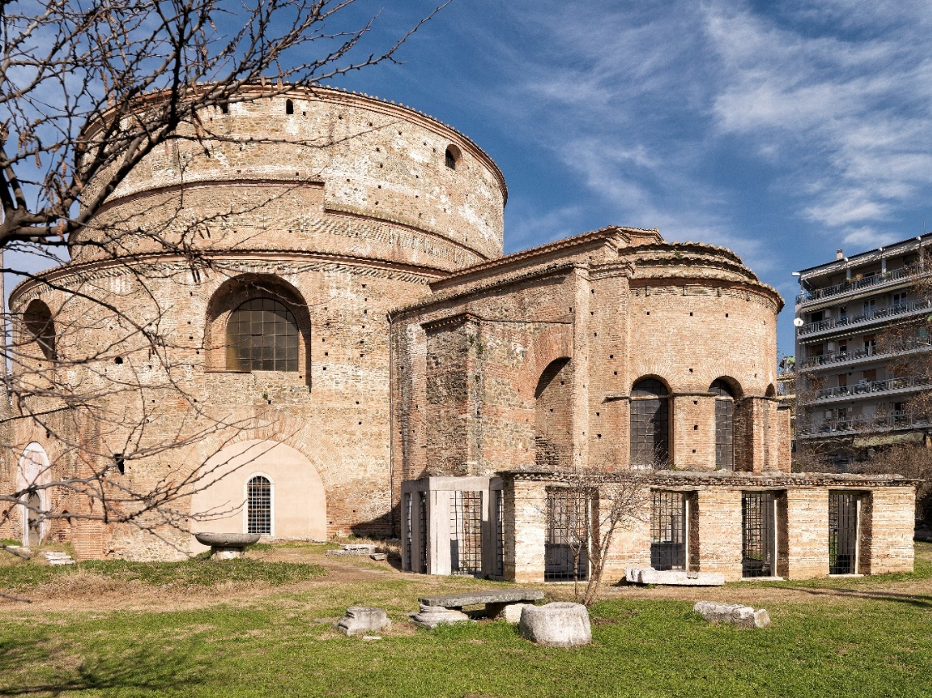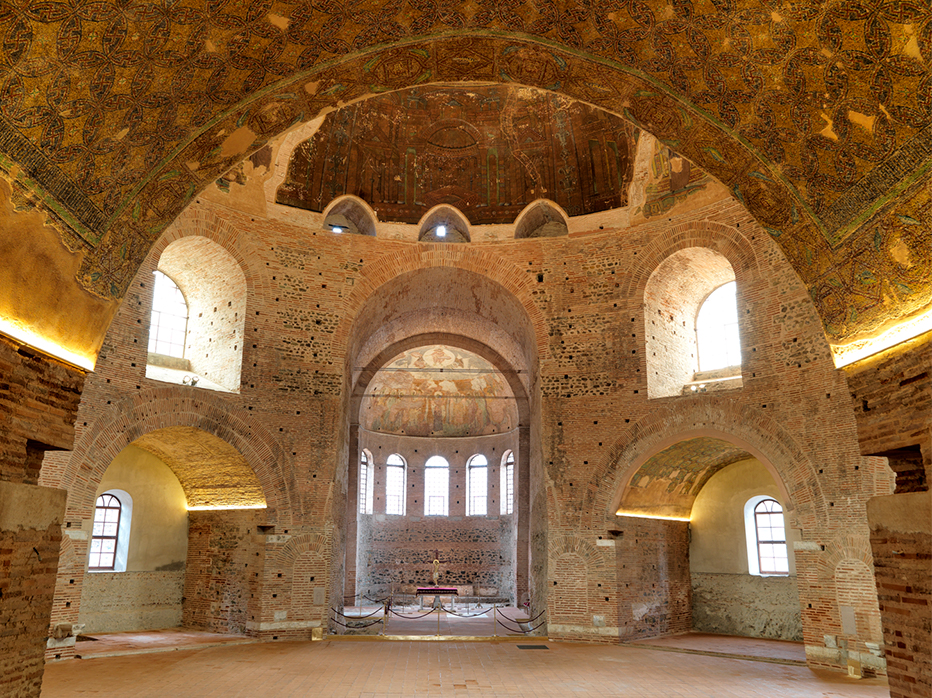In an imposing Award Ceremony, the Empress Theophano Prize was awarded to the scientist couple who developed the first vaccine against the coronavirus, in the presence of prominent personalities from Europe in the fields of politics, diplomacy, justice, science and culture
You may watch the Ceremony Award (Wednesday 13th October 2021 | 17:30 CET, 18:30 EET) HERE
Focusing on the critical role science serves in society and its contribution to the Common Good, the Award Ceremony for this year’s Empress Theophano Prize was completed on Wednesday, 13th of October at the emblematic Rotunda monument in Thessaloniki, in the presence of HE the President of the Hellenic Republic Katerina Sakellaropoulou. In an atmosphere permeated by strong emotion and heartfelt respect, the couple who developed the first vaccine against the novel coronavirus was honoured – Dr Uğur Şahin and Dr Özlem Türeci, the two scientists whose unwavering efforts to solve an unprecedented health crisis led them to a discovery that turned fear into hope not only in Europe but all across Humanity.
Referring to those values of the prize recipients that contribute to the promotion of scientific knowledge, HE the President of the Hellenic Republic, Katerina Sakellaropoulou, spoke of “Two great individuals who, after their triumphant success, were quick to state that the fruit of their research was a victory for innovation, science and global collaborative effort”.
The President of the Governing Committee of the Theophano Institution, Stavros Andreadis, expressed the awe with which he faces the recipients and noted that “Their work brings before us a series of important truths, the first being the critical role science plays in human wellbeing. The unfathomable power of the human spirit can and must serve the Common Good”.
The President of the Advisory Committee, Herman Count Van Rompuy, spoke about the laureates’ achievement, saying that, “Both have done what many of us societally aspire to do: they have turned fear into hope”, and underscored the necessity of collaboration, of which they are an example: “We are not safe in the world until all are safe. The problem is global but the policy is not global. More than ever we need global cooperation instead of global confrontation”.
Upon receiving the prize, Dr Özlem Türeci stressed the contribution of several generations of researchers to understanding mRNA technology, thanked the BioNTech team for this race to the vaccine that they named Project Lightspeed, as well as their close partner Albert Bourla, with whom they set everyone’s safety as their collaboration’s main commitment. Concluding, she said that “Science can – indeed – make a difference at global scale. But let’s not wait for the next global problem, the next big crisis, to create a sense of urgency”. Referring to mRNA technology as the new revolution in medicine, Dr Uğur Şahin noted, “Let us be brave and optimistic – The limits of the application of mRNA are the limits of biology. The world is in a phase right now where our knowledge of biology and disease is evolving dramatically. […] Let us understand our historical responsibility and think at a global scale […] We are very grateful to be here today and we can’t wait to contribute to a better tomorrow – together with trusted partners in the fields of science, economics and politics”.
The event was framed in particularly potent symbolism by the world debut of the innovative international MakeMusiCovit! Education Programme, in an original hybrid concert of Pan-European music collaboration which was designed amidst the pandemic under the direction of George Emmanuel Lazaridis (composer) and Safira Antzus Ramos (conductor). During the music performance, state-of-the-art technology and projection mapping techniques were used to project images of the Rotunda’s unique mosaics onto the monument’s three large arched openings.
The Award Ceremony honoured with their presence leading personalities from Europe, such as Mary McAleese, former President of Ireland; Tarja Halonen, former President of Finland; Rita Süssmuth, former President of the German Bundestag. Also attending were Deputy Minister for Macedonia and Thrace, Stavros Kalafatis; the Mayor of Thessaloniki, Konstantinos Zervas; the Chairman and CEO of Pfizer, Albert Bourla, while presenting the Award Ceremony was journalist and Executive Editor of Kathimerini newspaper Alexis Papahelas.
Award Ceremony sponsor for the second year was Eurobank, whose CEO, Fokion Karavias, stated, about this year’s award: “It is an achievement fully aligned with the values championed by the Prize, which was established with the aim to honour and promote people and institutions that contribute to the common good and improve everyone’s lives. Eurobank actively identifies with the values highlighted by this new institution and consistently seeks, both in its day-to-day business practices and a multifaceted matrix of Corporate Social Responsibility actions, to be useful to the societies in the countries where it has presence”.
The Empress Theophano Prize is awarded each year by the institution of the same name, the Theophano Foundation, as a distinction and without a monetary prize, through a process of evaluating candidates by the Foundation’s two main bodies: the Advisory and the Governing Committee.
The Award Ceremony was completed with the kind sponsorship of

Official air carrier sponsor

With the kind support of

INFORMATION: Vicky Papadimitriou, Project Coordination | E: info@theophano.eu | T: +30 6937 229858
The Advisory Council
Chairman
Herman Van Rompuy
President Emeritus of the European Council
Former Minister of State of Belgium (BE)
Members
Mary McAleese
Former President of Ireland | Professor of Children, Religion and Law, University Glasgow (IRL)
Leonie Bell
Trustee Edinburgh International Festival | Director Victoria & Albert Museum Dundee (UK)
Nikiforos Diamandouros
Former European Ombudsman (GR)
Élisabeth Guigou
President, Anna Lindh Foundation | Former Secretary of State (F)
Tarja Halonen
Former President of Finland (FI)
Agnieszka Holland
Author and film director (PL)
Maria Luisa Poncela
Former Secretary of State (ES)
Michel Praet
Vice-President Museum of European History (BE)
Georges Prevelakis
Professor Emeritus, Paris-Sorbonne University (FR)
Sir Ivan Rogers
Former UK Ambassador to the EU (UK)
Chiara Saraceno
Honorary fellow Collegio Alberto, University of Turin (IT)
Vassilios Skouris
Former President, European Court of Justice of the EU (GR)
Karl Prince zu Schwarzenberg
Former Minister of Foreign Affairs (CZ)
Rita Süssmuth
Former President of the German Parliament (DE)
Panos Tzonos
Professor Emeritus, Aristotle University of Thessaloniki (GR)
Luuk Van Middelaar
Professor of EU Foundations and Institutions, University of Leiden (NL)
The Governing Council
Chairman
Stavros Andreadis
Chairman, SANI/IKOS Group
Chairman, Cultural Society of Entrepreneurs of Northern Greece (GR)
Members
Nikolaos Efthymiadis
Chairman, EFTHYMIADIS Agrotechnology Group
Honorary Chairman, Federation of Greek Industries (GR)
Evangelos Gerovassiliou
Chairman, Gerovassiliou Wines (GR)
Constantinos Gleoudis
Chairman, KAVEX
Member of the Board, Hellenic Society for the Environment and Cultural Heritage (GR)
Theodoros Ikonomou
Chairman, Greek Forest Property Association
Head of a forest management and wood production firm (GR)
Nada Korac Kakabadse
Professor of Policy, Governance and Ethics, Henley Business School, University of Reading (UK)
George Mylonas
Chairman, ALUMIL Group (GR)
Sonja Puntscher-Riekmann
Professor Emeritus of Political Theory and European Politics, University of Salzburg (AT)
Stefan Schepers
Secretary General, High Level Groups on Policy Innovation (BE)
Vassos Konstantinidis
Chairman, INART (GR)
Empress Theophano
Empress Theophano, who inspired this prize, is a historic figure of Europe who played a significant role in its development during the 10th century.
The niece of Emperor John I Tzimiskes, she married Otto II and was crowned Holy Roman Empress as his wife. Following his death, she maintained the title of Empress. Her historic presence in Western Europe, dedicated to improving relations between East and West, offered a positive contribution to the cultural renaissance of western European territories, introducing to the west the central role women had in Byzantine society and transferring significant influence from the flourishing Byzantine empire in the fields of education, the arts, commerce, and health, while working to advance civil governance, promoting it over the military.
Empress Theophano is buried at the Cathedral of St Pantaleon in Cologne, Germany.
The Rotunda Monument
The emblematic monument of Thessaloniki, was constructed in the early 4th century AD, on the turning point between the pagan with the Christian world, probably as a temple for ancient cult worship or as a mausoleum for Constantine the Great (306-337). This circular, domed building measures 29.80 meters in height, 24.50 meters in diameter, its walls are 6.30 meters thick and can only be compared architecturally to the Pantheon in Rome. Not long after it was built and during the early years of the long-lived Byzantine Empire (330-1453), the Rotunda was turned into a Christian church with the addition of a sanctuary on its eastern side. The interior was decorated with Early Byzantine (4th- 6th c. AD) wall mosaics of unique artistry and beauty. It was Thessaloniki’s cathedral church (metropolis) between 1524 and 1591, the year in which it was converted to a mosque by the Ottoman conquerors. It remained in use as a mosque until the city’s liberation in 1912. Its dedication since that time to Saint George (Agios Georgios) is owing to the small neighboring church of this name. The mosaic decoration of the Rotunda is a masterpiece of Late Antique art.
Text source: http://galeriuspalace.culture.gr/en/monuments/rotonta/

Photo credits: Ephorate of Antiquities of Thessaloniki City.

Photo credits: Studio 8 Photos, Efi Panagoula.
